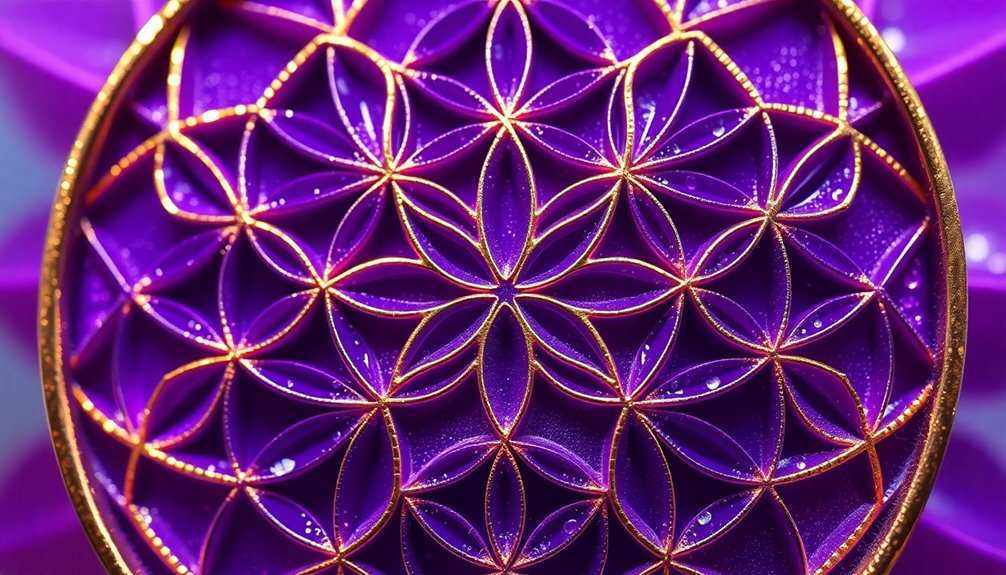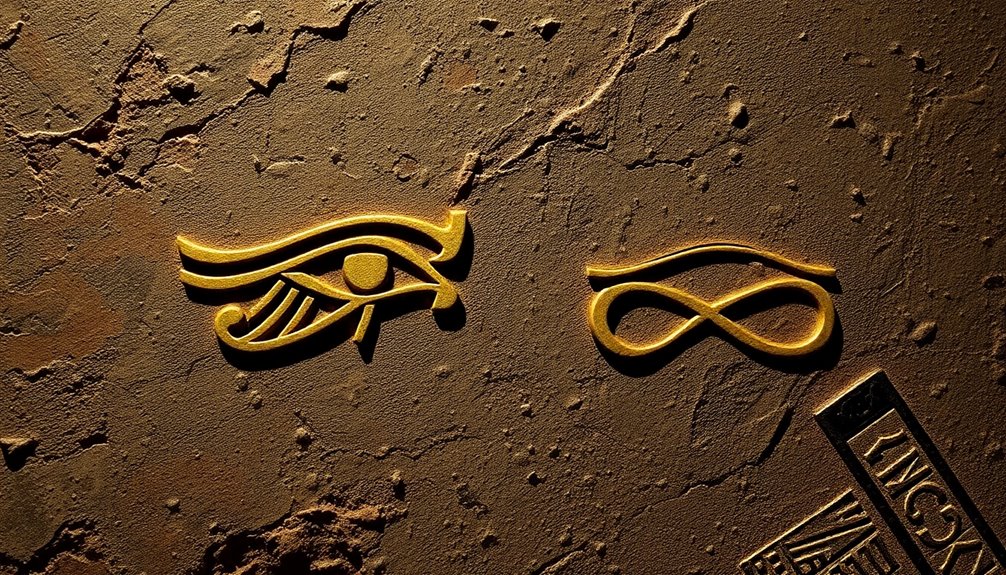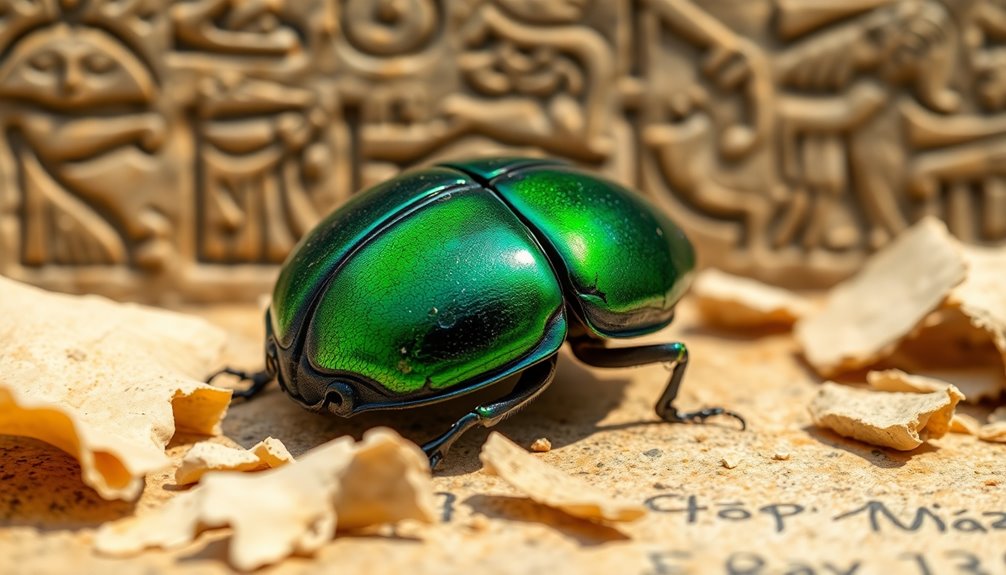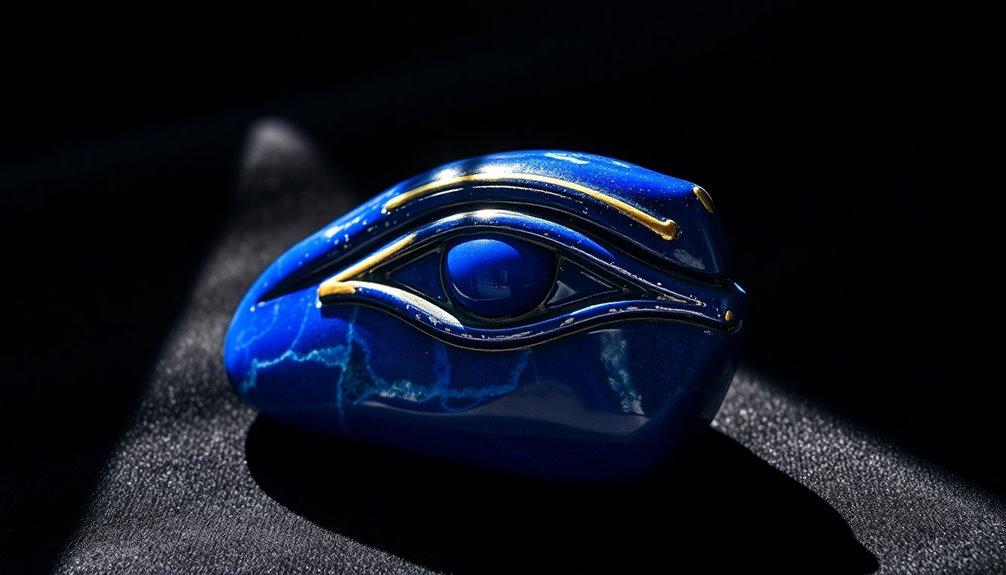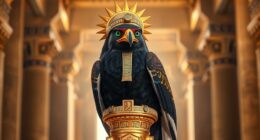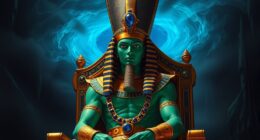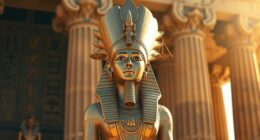The Eye of Horus holds deeper meanings tied to protection, health, and spiritual insight, often overlooked in traditional education. Each part of this symbol corresponds to a human sense, underscoring its connection to holistic well-being. Historically, it served as a powerful emblem for ancient Egyptians, representing the divine strength of Horus and safeguarding against negativity. It promotes emotional healing and personal growth while enhancing your awareness of life's mysteries. Through connections to higher consciousness, the Eye becomes a tool for inner harmony. Discover these insights further, and you'll uncover more layers to this ancient symbol's significance.
Key Takeaways
- The Eye of Horus symbolizes duality, representing both healing (left eye) and power (right eye) in ancient Egyptian culture.
- Each of its six parts corresponds to a human sense, reflecting a holistic approach to well-being and awareness.
- Historically, it was used in funerary practices as a protective symbol, ensuring safe passage and rebirth in the afterlife.
- The Eye of Horus serves as a powerful talisman, promoting emotional healing and safeguarding against negativity and misfortune.
- Engaging with the Eye through meditation enhances spiritual insights and fosters inner harmony, deepening personal growth.
Symbolism of the Eye of Horus

The Eye of Horus, often referred to as the Wedjat, carries profound symbolism in ancient Egyptian culture. This powerful emblem represents protection, health, and restoration, making it a crucial talisman for the living and the deceased.
You might find it fascinating that the Eye is intricately associated with the god Horus, who fought against Seth, symbolizing the triumph of good over evil.
The Eye of Horus is divided into six distinct parts, each corresponding to one of your senses—touch, taste, smell, sight, hearing, and wisdom. This division reflects a holistic understanding of existence and the interconnectedness of perception.
In ancient Egyptian culture, the left eye represents the moon and healing, while the right eye symbolizes the sun and power, showcasing the duality present in their beliefs.
Such symbolism isn't just decorative; it served practical purposes too. You'd discover that the Eye of Horus was commonly used in amulets and artwork to ward off evil and guarantee safety, emphasizing its importance in both daily life and the afterlife.
This ancient icon truly embodies the essence of protection and healing, connecting you to a rich cultural heritage.
Historical Significance in Ancient Egypt
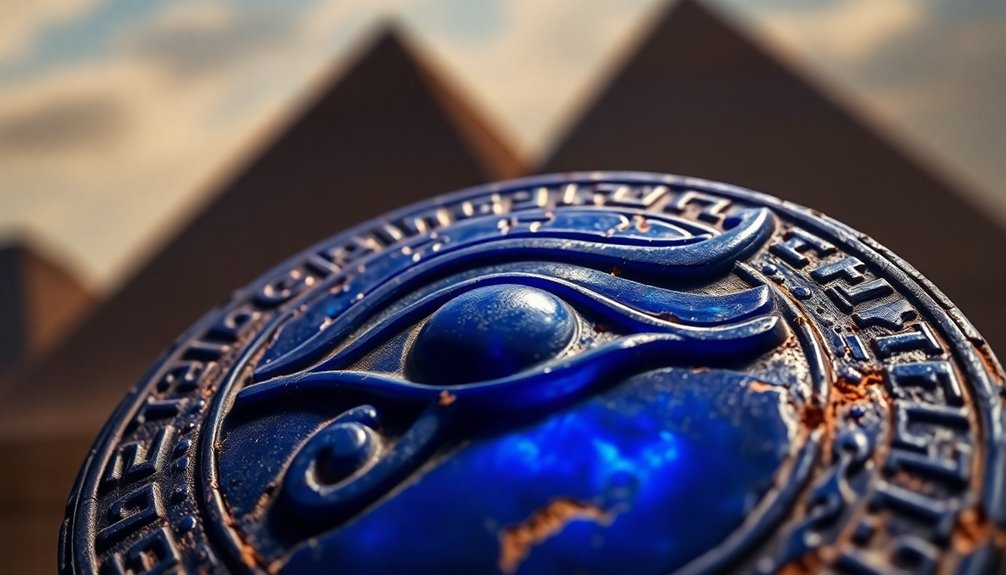
The Eye of Horus was more than just a symbol; it represented royal authority and protection, especially in funerary practices.
You'll find it prominently featured in art and culture, illustrating its deep-rooted significance in ancient Egyptian society.
Understanding its historical importance helps you appreciate how integral this symbol was to their beliefs and practices.
Symbol of Royal Authority
Rooted deeply in ancient Egyptian culture, the Eye of Horus stands out as a powerful symbol of royal authority. You can see how it's intricately woven into the fabric of kingship, linking pharaohs directly to the divine. The Eye of Horus, often depicted in royal regalia, embodies the divine protection granted to rulers, reinforcing their right to govern.
| Symbolic Aspect | Significance |
|---|---|
| Eye of Horus | Emblem of divine protection |
| Royal Regalia | Represents authority and power |
| Kingship | Mediator between gods and people |
| Ancient Egyptian Art | Highlights connection to the divine |
In ancient Egyptian art, the Eye of Horus frequently appears alongside other powerful symbols, like the ankh and sistrum. This visual representation emphasizes the pharaoh's role as a divine leader. Additionally, the Eye is linked to the concept of Ma'at, symbolizing truth and balance, essential traits for maintaining societal harmony. Understanding these connections reveals why the Eye of Horus was more than just a symbol; it was a representation of the pharaoh's divine right to rule.
Protection in Funerary Practices
In ancient Egypt, the Eye of Horus served an essential role beyond just royal authority; it also provided profound protection in funerary practices. This powerful symbol was frequently painted on coffins and burial items, aimed at ensuring the deceased's safe passage into the afterlife and warding off evil spirits.
By incorporating the Eye of Horus, ancient Egyptians believed they could restore health and well-being to the mummies, reflecting a deep-seated hope for rebirth and rejuvenation after death.
Funerary amulets featuring the Eye of Horus were commonly placed with mummies, acting as a shield against negative forces that could disrupt their journey. The symbol's association with Horus's victory over Set reinforced its significance, embodying the promise of divine protection for the deceased.
You'd often find the Eye adorning tomb art and inscriptions, serving as a lasting reminder of the eternal connection between the living and the dead.
In this way, the Eye of Horus wasn't merely a decorative motif; it was a crucial element in ancient Egyptian funerary practices, offering comfort and assurance that the deceased would be safeguarded in the domain beyond.
Influence on Art and Culture
While exploring the art and culture of ancient Egypt, you'll quickly notice the Eye of Horus as a recurring motif, deeply woven into the fabric of their creative expression. This symbol represented protection and health, often depicted in tombs and temples to signify divine watchfulness over the deceased.
Artists skillfully incorporated the Eye of Horus into their works, reinforcing the pharaoh's connection to the gods, which bolstered royal authority within the cultural narrative of ancient Egypt.
The Eye of Horus wasn't just a decorative element; it played a crucial role in everyday life. You'd find it on various artifacts, including amulets and jewelry, believed to offer the wearer protection and healing from misfortune and illness.
Hieroglyphs featuring the Eye served dual purposes, acting both as art and a means of communication, embodying complex ideas tied to divinity, protection, and prosperity.
Its consistent presence in ancient Egyptian art underscores a society deeply invested in balancing life and death, emphasizing the importance of safeguarding both the physical and spiritual domains from harm.
The Eye of Horus remains a powerful symbol, echoing the beliefs and values of a remarkable civilization.
Mythological Background of Horus
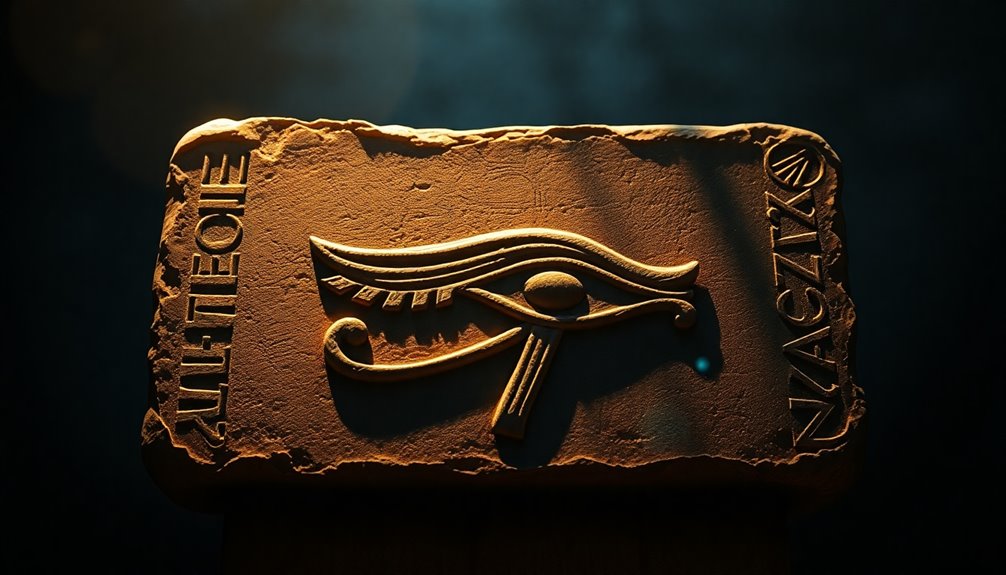
The story of Horus unfolds as a fascinating saga of divine struggle and triumph in ancient Egyptian mythology. As the son of Osiris and Isis, Horus was conceived during Osiris's resurrection, marking a pivotal moment that emphasizes themes of rebirth and vengeance.
His conflict with his uncle Seth, who murdered Osiris, lasted an astonishing 80 years, featuring numerous contests to establish rightful kingship over Egypt.
During one fierce battle, Horus lost his left eye, a significant event symbolizing sacrifice and the ongoing struggle between good and evil. This loss held substantial weight in the narrative, embodying the trials he faced.
However, the restoration of his eye by the god Thoth signifies healing and completeness, transforming it into a powerful emblem of protection.
Horus's eventual victory over Seth encapsulates broader themes of justice, order, and balance restoration in the universe. Through his mythology, you witness the eternal fight against chaos, making the Eye of Horus not just a symbol of protection but also a reminder of the resilience inherent in the cycle of life, death, and rebirth.
Healing and Protection Properties
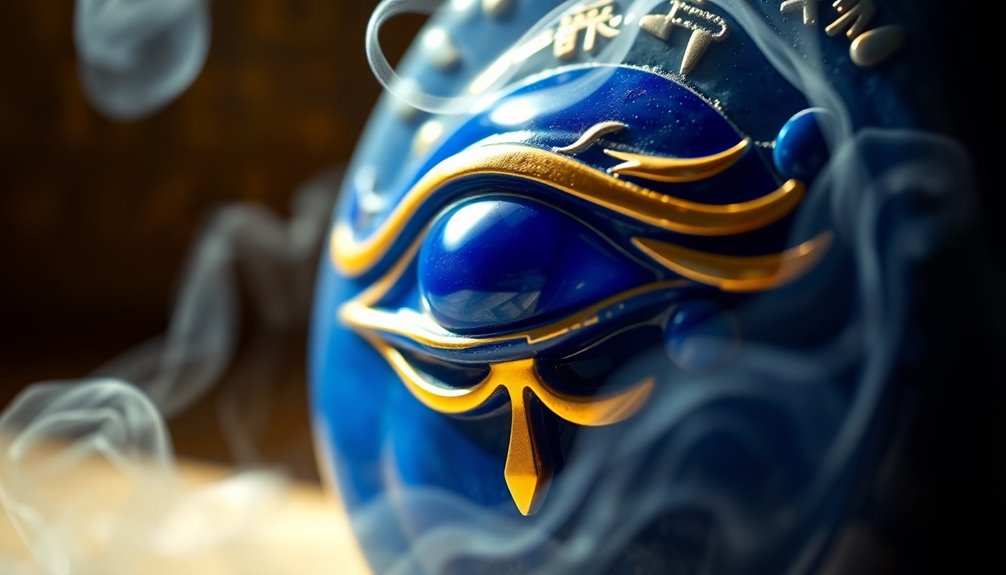
The Eye of Horus has long been valued as a powerful talisman, offering protection and healing to those who wear it.
Today, you can find it in modern jewelry, serving not just as a fashionable piece but as a symbol of spiritual well-being.
Talismanic Significance in Amulets
Throughout history, the Eye of Horus has held profound talismanic significance, particularly in amulets aimed at healing and protection. When you wear a talismanic amulet featuring the Eye of Horus, you tap into its powerful symbolism, believed to shield you from evil forces and negative energies. Each of the six parts of the Eye corresponds to a specific sense, collectively representing wholeness and spiritual completeness.
In ancient Egyptian culture, these amulets were often placed on burial items or worn as jewelry to guarantee safe passage to the afterlife and promote the healing process for the wearer. The Eye of Horus symbolizes restoration, emphasizing the balance between physical health and spiritual well-being.
Wearing an amulet adorned with the Eye of Horus is thought to cleanse toxicity and negative energy, fostering inner harmony and well-being. This connection to ancient practices continues to resonate today, reminding you of the importance of protection and healing in your life.
Modern Uses in Jewelry
In today's world, many people incorporate the Eye of Horus into their jewelry—like necklaces and bracelets—seeking its protective and healing properties. This ancient symbol resonates deeply with those looking for spiritual connection and emotional healing.
Wearing Eye of Horus jewelry is believed to offer various benefits, including:
- Protection: It serves as a shield against negative energies, promoting a sense of safety.
- Good Fortune: Many wear it to attract luck and prosperity into their lives.
- Emotional Healing: The Eye of Horus symbolizes resilience, helping you navigate through emotional challenges.
- Aesthetic Appeal: Modern designs often feature intricate patterns, blending beauty with powerful symbolism.
Red string bracelets adorned with the Eye of Horus are particularly popular, as they're thought to deflect negativity and invite positivity.
This connection to holistic well-being makes the Eye of Horus a staple in contemporary spiritual practices. By wearing this symbol, you remind yourself of its rich history while embracing its protective and healing qualities.
Whether you're drawn to its beauty or its significance, the Eye of Horus continues to inspire and empower.
Spiritual Healing Practices
Incorporating the Eye of Horus into spiritual healing practices enhances its protective and restorative properties. This ancient symbol promotes balance and harmony within your body and mind, fostering overall well-being.
Its six components symbolize your human senses, guiding you on a path to enlightenment that connects you to your higher self for emotional and spiritual healing.
Wearing Eye of Horus jewelry, like a necklace or bracelet, serves as an energy shield, deflecting negativity and attracting positive energy and good luck.
This connection to protection isn't just modern; ancient Egyptians used the Eye of Horus in amulets to guard against illness, highlighting its historical significance in spiritual practices. Moreover, understanding the soulmate angel numbers can deepen your connection to spiritual energies, enhancing your healing journey.
Connection to Higher Consciousness

For centuries, the Eye of Horus has served as a powerful symbol of connection to higher consciousness, enabling you to tap into divine wisdom and spiritual insights.
This ancient emblem not only represents the six neuroanatomical elements tied to your senses but also encourages you to transcend limitations, promoting emotional healing and resilience.
By engaging with the Eye of Horus, you can foster a deeper connection to your true self and the universe.
Here are four key benefits of this connection:
- Access Divine Wisdom: The Eye acts as a conduit for receiving insights from higher dimensions.
- Enhance Spiritual Awareness: It allows you to recognize the interplay between physical perception and spiritual truths.
- Promote Emotional Healing: Engaging with this symbol helps cleanse negative energy, facilitating resilience.
- Guide Personal Growth: The Eye of Horus supports your journey toward self-discovery and fulfillment.
Embracing the Eye in your spiritual practices can lead to inner harmony, enriching your life with profound insights and fostering a strong connection to higher consciousness.
Modern Interpretations and Uses
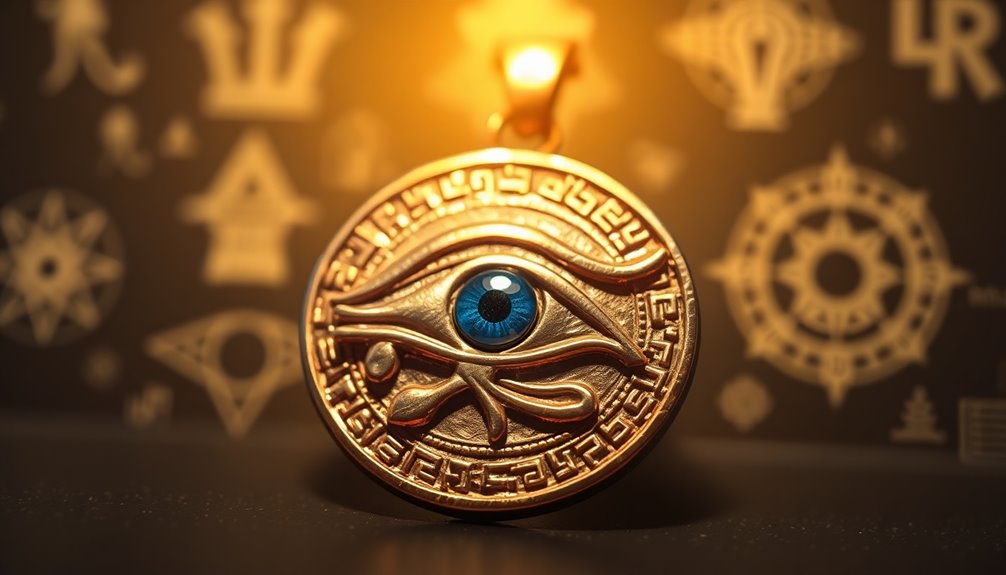
Today, you'll find the Eye of Horus everywhere, from jewelry to tattoos, symbolizing protection and resilience.
Many people embrace it as a spiritual talisman, believing it shields them from negativity while attracting positive energy.
Its ancient roots continue to influence modern spiritual practices, highlighting the connection between the physical and spiritual domains.
Contemporary Symbolism Today
While many people may see the Eye of Horus as just an intriguing design, it carries profound meanings in contemporary culture, representing protection, health, and spiritual guidance. This ancient symbol has evolved, finding relevance in various aspects of modern life.
Here are some contemporary interpretations and uses of the Eye of Horus:
- Powerful Talisman: Many individuals incorporate the Eye of Horus into their spiritual practices, believing it offers protection and promotes resilience in tough times.
- Emotional Healing: In holistic healing, practitioners use the symbol to enhance emotional healing and foster a deeper connection to higher consciousness.
- Artistic Inspiration: Artists and designers often blend the Eye of Horus with contemporary aesthetics, creating pieces that embody themes of empowerment and spiritual insight.
- Symbol of Knowledge: Groups like the Freemasons adopt the symbol to represent divine watchfulness and the pursuit of knowledge, showcasing its enduring significance.
In a world filled with distractions, the Eye of Horus stands as a reminder of the importance of protection and spiritual guidance, making it a relevant symbol for many today.
Jewelry and Tattoos
The Eye of Horus has made a significant mark in the domains of jewelry and tattoos, transforming from an ancient symbol into a modern emblem of personal expression and protection. In today's world, you'll find the Eye of Horus gracing necklaces, bracelets, and earrings, crafted from precious metals like silver and gold. These pieces not only look stylish but also embody themes of resilience, healing, and divine guidance.
When it comes to tattoos, the Eye of Horus serves as a permanent reminder of protection, blending historical significance with aesthetic appeal. Many choose this design to reflect their personal beliefs and experiences, creating a deep connection to the symbolism it carries.
Here's a quick look at the emotional impact of the Eye of Horus in jewelry and tattoos:
| Aspect | Jewelry | Tattoos |
|---|---|---|
| Protection | Amulet-like charm | Permanent safeguard |
| Symbolism | Spiritual connection | Personal belief |
| Healing | Emotional support | Recovery journey |
| Style | Fashion statement | Unique expression |
| Relevance | Ancient to modern | Timeless significance |
The integration of the Eye of Horus in modern fashion reflects the growing trend towards clean beauty and unique personal expression. Embrace the Eye of Horus as a powerful symbol in your life!
Spiritual Practices Influence
Incorporating the Eye of Horus into your spiritual practices can deepen your connection to protection and guidance. This ancient symbol serves as a powerful tool to enhance your journey toward self-awareness and emotional healing.
Here are some modern interpretations and uses you might consider:
- Jewelry: Wear Eye of Horus necklaces or bracelets to create an energetic shield against negativity, promoting a sense of safety and spiritual growth.
- Meditation: Use the Eye of Horus during meditation to access higher states of consciousness, allowing you to tap into divine wisdom and clarity.
- Visualization: Incorporate the symbol in visualization exercises to manifest intentions and attract positive energy into your daily life.
- Artistic Expression: Consider incorporating the Eye of Horus into tattoos or artwork, reflecting your desire for resilience and a connection to ancient wisdom.
Everyday Applications of the Symbol
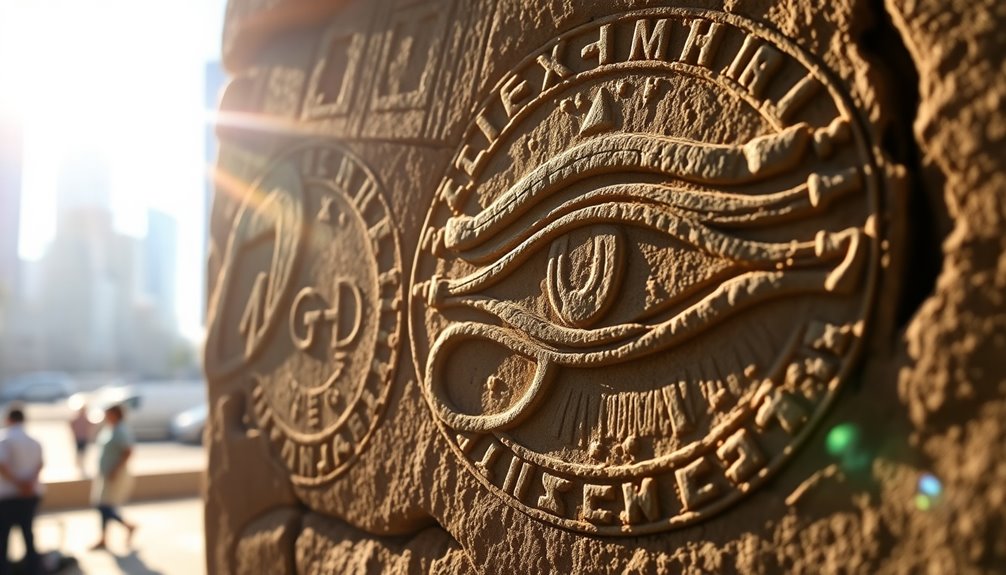
You can easily integrate the Eye of Horus into your daily life through various applications that enhance your well-being. This powerful symbol of protection can manifest in numerous ways, providing good luck and emotional healing. Below are some practical applications:
| Application | Benefits |
|---|---|
| Jewelry | Wearing necklaces or bracelets can shield you from negative energy while attracting positive vibes. |
| Keychains | Carrying an Eye of Horus keychain offers a portable talisman, bringing protection and positivity wherever you go. |
| Home Decor | Incorporating the symbol in wall art or sculptures can infuse your space with protective energy, promoting harmony. |
| Meditation | Visualizing the Eye of Horus during mindfulness practices deepens your spiritual connection and aids in emotional healing. |
Incorporating the Eye of Horus into your routine not only enhances your spiritual practices but also fosters a sense of security and well-being. Embrace this ancient symbol to navigate life's challenges with greater intuition and resilience. Additionally, being mindful of gastrointestinal issues can be essential when adopting new health practices, ensuring a balanced approach to well-being.
Cultural Impact and Legacy
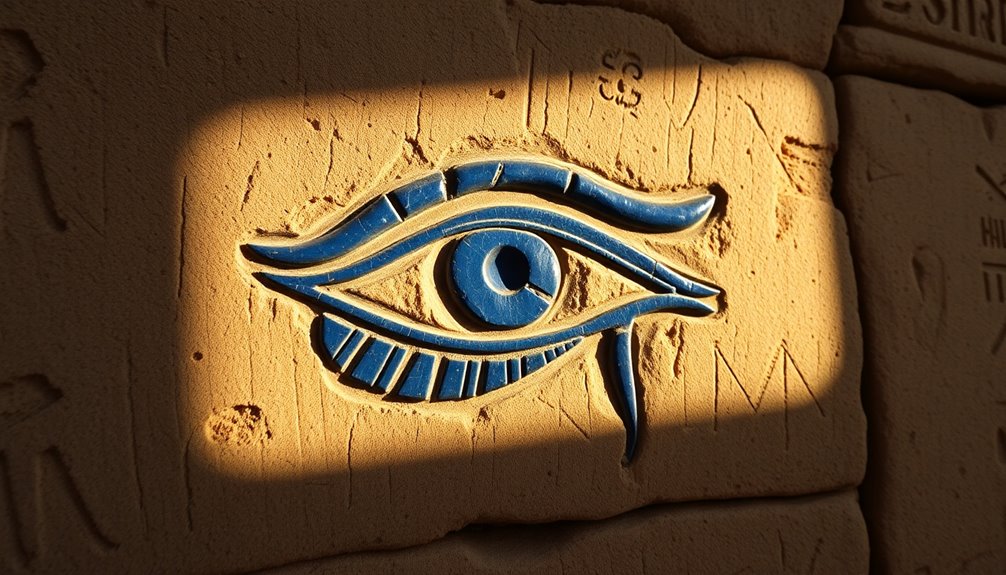
Throughout history, the Eye of Horus has transcended its origins in ancient Egypt, leaving a lasting mark on various cultures worldwide. This powerful symbol has come to represent more than just its mythological roots; it embodies themes of protection, health, and prosperity.
Its cultural impact and legacy can be seen in several ways:
- Tomb Art: Ancient Egyptians depicted the Eye of Horus in tombs and temples, emphasizing its role in ensuring protection in the afterlife.
- Modern Organizations: Groups like the Freemasons have adopted this symbol, interpreting it as a sign of divine guidance and watchfulness.
- Contemporary Fashion: Today, the Eye of Horus inspires tattoos and fashion, symbolizing resilience, healing, and spiritual connection.
- Popular Culture: Its legacy lives on in movies and literature, where it represents mystery, wisdom, and the triumph of good over evil.
The Eye of Horus in Art
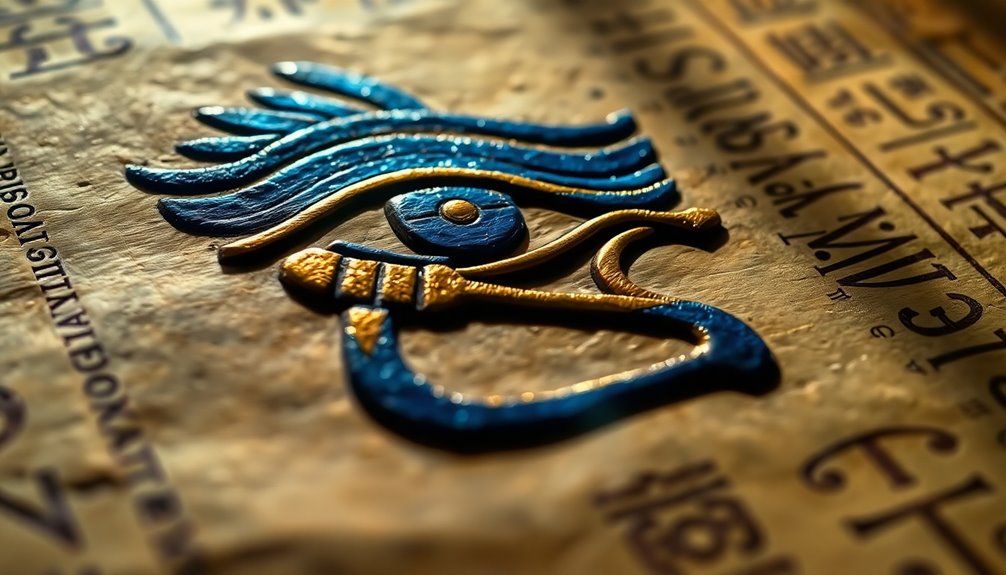
The Eye of Horus, often seen in ancient Egyptian art, serves as a powerful symbol of protection and health. You'll find this emblem frequently in tomb decorations and funerary items, where it's designed to safeguard the deceased in the afterlife.
Artists skillfully incorporated the Eye of Horus into various forms, including paintings, carvings, and jewelry, showcasing its role as a protective amulet for both the living and the dead.
Hieroglyphs featuring the Eye of Horus adorned the walls of temples and tombs, acting as a visual language that conveyed themes of divine protection and royal authority. You can appreciate the intricate details of the symbol, which represent the six senses, reflecting the Egyptians' profound understanding of human perception and spirituality.
This visual richness not only enhances the aesthetic appeal but also deepens its meaning.
Furthermore, the Eye of Horus often appears in royal regalia, emphasizing the divine right of pharaohs to rule and their connection to the gods.
Spiritual Pathways and Insights
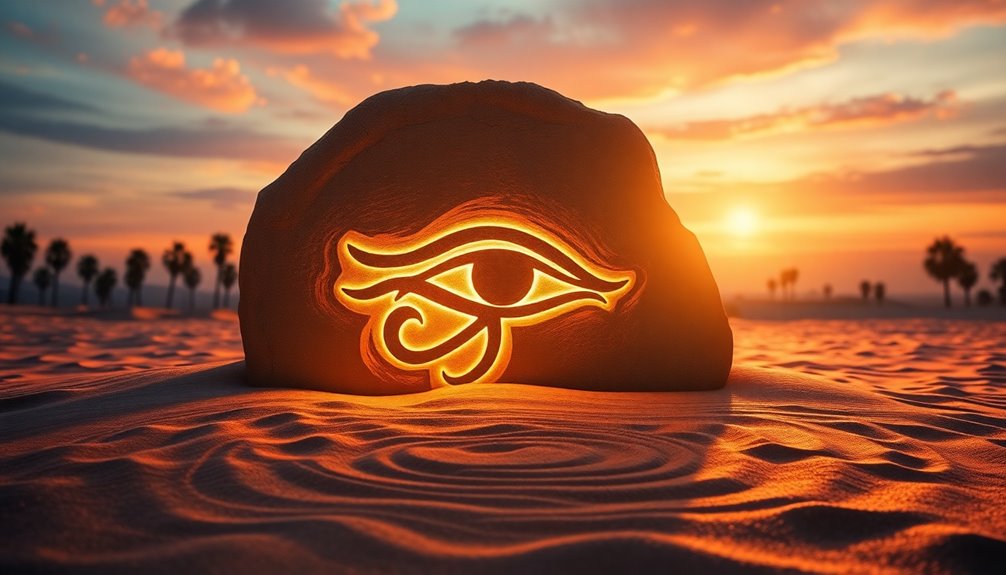
Embracing the Eye of Horus in your spiritual journey can reveal profound insights and deepen your intuitive abilities. This ancient symbol not only fosters a strong spiritual connection but also serves as a powerful tool for protection and personal growth.
Here are four ways to incorporate the Eye of Horus into your spiritual practice:
- Enhance Intuition: Meditate on the Eye of Horus to tap into your inner wisdom and amplify your intuitive senses.
- Embrace Resilience: Reflect on the myth of Horus and recognize how challenges can lead to spiritual elevation and personal development.
- Protect Your Energy: Use the Eye of Horus as a talisman to shield yourself from negative influences, creating a harmonious space for growth.
- Foster Inner Balance: Integrate this symbol into your daily life to remind yourself of the importance of balance and harmony on your path to enlightenment. Additionally, recognizing the power of subconscious power during sleep can enhance your spiritual practice and connection to the Eye of Horus.
Frequently Asked Questions
What Is the Deeper Meaning of the Eye of Horus?
The Eye of Horus symbolizes protection, healing, and restoration.
When you explore deeper, you'll find it represents the balance of dual forces in life—like the sun and moon. Its six parts connect to completeness, embodying the idea of divine wholeness.
You might see it in amulets or funerary practices, used to safeguard the deceased.
This powerful symbol illustrates resilience and the triumph of good over chaos, making it significant in both physical and spiritual domains.
What Is the Secret of the Eye of Horus?
The Eye of Horus isn't just a symbol; it's like a cosmic shield, radiating protection and wisdom.
At its core, the secret lies in its ability to connect you with ancient energies, guiding you through life's challenges.
Each part of the eye holds a key to understanding your senses and existence.
What Does the Bible Say About the Eye of Horus?
The Bible doesn't mention the Eye of Horus directly since it's an ancient Egyptian symbol.
However, you might find some parallels in themes of protection and divine watchfulness. For instance, Psalm 121:7-8 emphasizes God's safeguarding presence, similar to the Eye's protective connotation.
While the Eye of Horus isn't biblically rooted, it's often discussed in esoteric contexts, which may contrast with biblical teachings against idolatry and false worship.
Is the Eye of Horus Good or Bad?
Picture a glimmering amulet nestled against your chest, radiating warmth and protection. The Eye of Horus isn't inherently good or bad; it depends on how you see it.
Traditionally, it's a symbol of safeguarding, healing, and fortune, warding off negativity. However, it also embodies divine judgment, reminding you that actions have consequences.
Embrace its positive attributes, and let it inspire a sense of protection in your journey through life.
Conclusion
As you explore the depths of the Eye of Horus, you uncover a treasure chest of wisdom and protection. This ancient symbol is more than just an emblem; it's a beacon guiding you through the shadows of ignorance. Imagine it as a lighthouse, illuminating your path to higher consciousness and spiritual growth. Embrace its legacy, and let its healing energy weave through your everyday life, transforming mundane moments into sacred experiences filled with meaning and insight.


